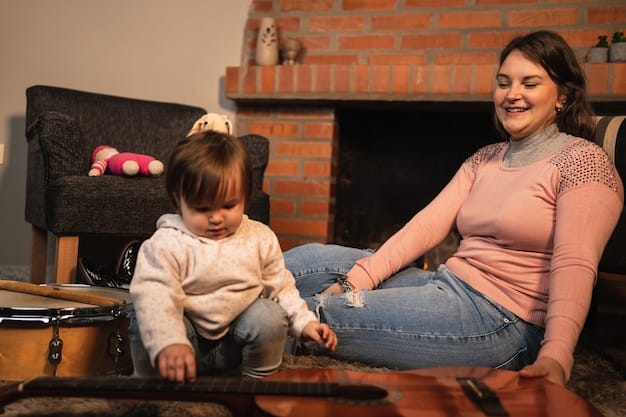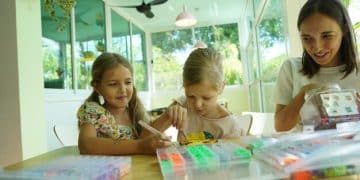Potty Training: A Stress-Free Step-by-Step Guide for Parents

Potty training can be a daunting task for parents, but with the right approach, it can be achieved without stress; this step-by-step guide offers practical tips and strategies for successful and positive potty training.
Embarking on the potty training without the stress: a step-by-step guide for success journey can feel overwhelming. However, with the right approach, patience, and understanding, you can make this milestone a positive experience for both you and your child.
Understanding Readiness for Potty Training
Before diving into the process, it’s crucial to determine if your child is truly ready for potty training. Pushing a child before they’re ready can lead to frustration and setbacks. Look for signs that indicate readiness, both physical and emotional.
Physical Readiness Signs
Physical readiness is essential as it indicates the child’s ability to control their bladder and bowels.
- Staying Dry: Can stay dry for at least two hours during the day.
- Predictable Bowel Movements: Has regular and predictable bowel movements.
- Motor Skills: Can pull pants up and down independently.
Emotional and Cognitive Readiness Signs
Emotional and cognitive readiness are equally important to ensure a smooth transition. A child who is emotionally ready is more likely to cooperate and engage positively in the process.
- Interest in the Toilet: Shows curiosity about the toilet or bathroom habits of others.
- Verbal Communication: Can communicate when they need to go to the bathroom.
- Desire for Independence: Expresses a desire to be more independent.
It’s essential to observe your child closely and consider these signs collectively. If your child exhibits most of these signs, they are likely ready to begin potty training. Remember, every child is different, and there’s no set age to start.

Preparing for Potty Training
Once you’ve determined that your child is ready, preparation is key to a successful potty training experience. Set the stage by gathering the necessary supplies and creating a supportive environment.
Choose the Right Potty Training Equipment
- Potty Chair or Toilet Seat Reducer: Select a potty chair that is comfortable and stable or a toilet seat reducer that fits securely on your toilet.
- Step Stool: A step stool can help your child reach the toilet and sink independently.
- Training Pants: Purchase several pairs of training pants for daytime use.
- Rewards: Small rewards like stickers, books, or small toys can motivate your child.
Create a Potty Training Schedule
Establishing a routine can help your child understand when and how often they should try to use the potty. Start by taking your child to the potty at regular intervals, such as every two hours, and after waking up from naps.
Talk to Your Child About Potty Training
Explain the process to your child in simple terms. Read books about potty training together and watch videos that demonstrate the process. Use positive language and avoid making it seem like a chore.
Preparing for potty training involves gathering the right equipment, establishing a routine, and communicating effectively with your child. These steps will create a supportive and encouraging environment, making the process smoother for everyone involved.
Starting the Potty Training Process
With the preparations in place, it’s time to start the potty training process. This phase requires patience, consistency, and a positive attitude. Begin with introducing the potty and establishing regular routines.
Introduce the Potty
Place the potty chair in an accessible and comfortable location. Encourage your child to sit on it fully clothed to get used to the feel. Make it a regular part of their routine, such as after meals or during playtime.
Establish a Potty Routine
Take your child to the potty at regular intervals, such as every two hours. Encourage them to sit on the potty for a few minutes. If they successfully use the potty, offer praise and a small reward. If not, don’t pressure them; simply try again later.
Use Positive Reinforcement
Praise and rewards can be highly motivating for young children. Offer praise, stickers, or small toys when your child uses the potty successfully. Avoid punishment or scolding for accidents, as this can create negative associations.
Starting the potty training process requires introducing the potty in a relaxed manner, establishing a consistent routine, and using positive reinforcement. These strategies will help your child feel more comfortable and confident as they learn to use the potty.
Handling Accidents and Setbacks
Accidents are a normal part of the potty training process. Knowing how to handle them effectively can prevent frustration and keep your child motivated. It’s also important to recognize and address any potential setbacks.
- Stay Calm: React calmly and reassure your child that accidents happen.
- Clean Up Together: Involve your child in the clean-up process to help them understand the consequences of accidents.
- Avoid Blame: Do not scold or punish your child for accidents. Instead, focus on encouraging them to try again next time.
Recognizing and Addressing Setbacks
Setbacks can occur for various reasons, such as illness, stress, or changes in routine. If your child experiences a setback, it’s important to address the underlying cause.

- Identify the Cause: Determine if there are any specific triggers for the setbacks.
- Adjust Your Approach: If setbacks are frequent, consider revisiting earlier stages of potty training.
- Seek Professional Advice: If setbacks persist, consult with your pediatrician or a potty training specialist.
Handling accidents and setbacks with patience and understanding is essential for maintaining a positive potty training experience. By staying calm, involving your child in the clean-up process, and addressing any underlying causes of setbacks, you can help your child stay on track.
Nighttime Potty Training
Nighttime potty training is different from daytime training and requires a separate approach. Many children achieve daytime dryness before they can stay dry overnight. Here are some steps to help with nighttime potty training.
Assessing Nighttime Readiness
Before starting nighttime potty training, assess whether your child is ready. Signs of readiness include waking up dry most mornings and showing an interest in staying dry overnight.
Limiting Fluids Before Bedtime
Reduce fluid intake in the hours leading up to bedtime. Encourage your child to use the potty right before going to bed.
Using Protective Bedding
Use waterproof mattress protectors to protect your child’s bed from accidents. Consider using training pants or nighttime diapers as a backup.
Establishing a Nighttime Routine
Create a consistent bedtime routine that includes a final trip to the potty. Make sure your child’s bedroom is easily accessible in case they need to use the potty during the night.
Nighttime potty training often takes longer than daytime training. Be patient and supportive, and celebrate small successes along the way. Remember, it’s normal for children to take longer to achieve nighttime dryness.
Maintaining Consistency and Patience
Consistency and patience are key to successful potty training. Establishing consistent routines and maintaining a patient and supportive attitude will help your child progress at their own pace.
Consistency in Routine
Stick to a regular potty schedule, even on weekends and holidays. Consistency helps your child understand when and how often they should try to use the potty.
Positive Reinforcement
Continue to offer praise and rewards for successful potty trips. Positive reinforcement can help your child stay motivated and confident.
Staying Patient and Supportive
Potty training can be challenging, and it’s important to remain patient and supportive throughout the process. Avoid getting frustrated or angry, as this can create negative associations with potty training.
Maintaining consistency and patience is essential for creating a positive potty training experience. By sticking to a regular routine, offering positive reinforcement, and staying patient and supportive, you can help your child achieve success at their own pace.
| Key Point | Brief Description |
|---|---|
| 👶 Readiness Signs | Look for physical and emotional cues before starting. |
| 🚽 Potty Routine | Establish regular times for potty breaks. |
| ⭐ Positive Reinforcement | Reward successes with praise and small gifts. |
| 🌙 Nighttime Training | Limit fluids and use protective bedding. |
▼
Most children show signs of readiness between 18 months and 3 years. Look for physical and emotional cues rather than focusing solely on age. Each child develops at their own pace, so patience is key.
▼
The duration of potty training varies widely. Some children master it in a few weeks, while others take several months. Consistency, positive reinforcement, and patience are vital for a successful outcome.
▼
If your child refuses, avoid forcing them. Take a break and revisit potty training later. Ensure they feel comfortable and not pressured. Positive encouragement and making it fun can often help.
▼
Setbacks are normal. Stay calm, avoid scolding, and offer reassurance. Assess if any stressors are causing the setbacks and adjust your approach to be more supportive and less demanding during those times.
▼
Yes, nighttime training often takes longer. Limit fluids before bed, ensure a potty trip before sleep, and use protective bedding. Patience is crucial, as nighttime dryness is often achieved later than daytime control.
Conclusion
Potty training without the stress: a step-by-step guide for success can be a rewarding journey with the right approach. By understanding your child’s readiness, preparing effectively, staying consistent, and maintaining patience, you can navigate this milestone with confidence and support your child’s independence.





